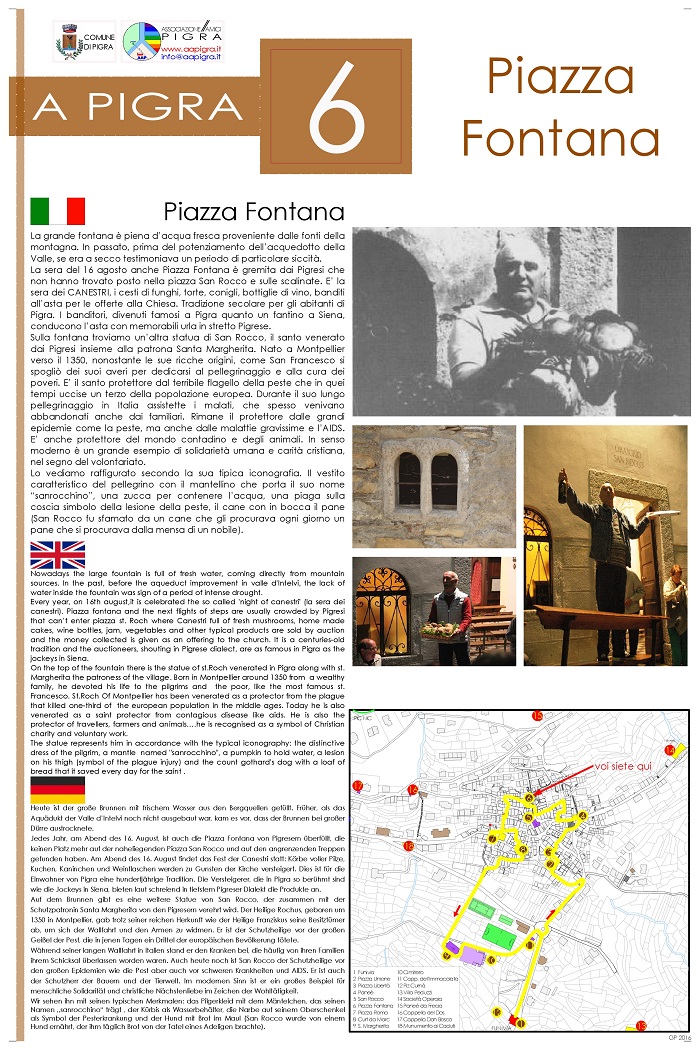Pigra da Scoprire
6 - Piazza Fontana

La grande fontana è piena d’acqua fresca proveniente dalle fonti della montagna. In passato, prima del potenziamento dell’acquedotto della Valle, se era a secco testimoniava un periodo di particolare siccità.
La sera del 16 agosto anche Piazza Fontana è gremita dai Pigresi che non hanno trovato posto nella piazza San Rocco e sulle scalinate. E’ la sera dei CANESTRI, i cesti di funghi, torte, conigli, bottiglie di vino, banditi all’asta per le offerte alla Chiesa. Tradizione secolare per gli abitanti di Pigra. I banditori, divenuti famosi a Pigra quanto un fantino a Siena, conducono l’asta con memorabili urla in stretto Pigrese.
Sulla fontana troviamo un’altra statua di San Rocco, il santo venerato dai Pigresi insieme alla patrona Santa Margherita. Nato a Montpellier verso il 1350, nonostante le sue ricche origini, come San Francesco si spogliò dei suoi averi per dedicarsi al pellegrinaggio e alla cura dei poveri. E’ il santo protettore dal terribile flagello della peste che in quei tempi uccise un terzo della popolazione europea. Durante il suo lungo pellegrinaggio in Italia assistette i malati, che spesso venivano abbandonati anche dai familiari. Rimane il protettore dalle grandi epidemie come la peste, ma anche dalle malattie gravissime e l’AIDS. E’ anche protettore del mondo contadino e degli animali. In senso moderno è un grande esempio di solidarietà umana e carità cristiana, nel segno del volontariato.
Lo vediamo raffigurato secondo la sua tipica iconografia. Il vestito caratteristico del pellegrino con il mantellino che porta il suo nome “sanrocchino”, una zucca per contenere l’acqua, una piaga sulla coscia simbolo della lesione della peste, il cane con in bocca il pane (San Rocco fu sfamato da un cane che gli procurava ogni giorno un pane che si procurava dalla mensa di un nobile).

Nowadays the large fountain is full of fresh water, coming directly from mountain sources. In the past, before the aqueduct improvement in valle d'Intelvi, the lack of water inside the fountain was sign of a period of intense drought.
Every year, on 16th august,it is celebrated the so called 'la sera dei canestri'. Piazza fontana and the next flights of steps are usually crowded by Pigresi that can’t enter piazza st. Roch where Baskets full of fresh mushrooms, home made cakes, wine bottles, jam, vegetables and other typical products are sold by auction and the money collected is given as an offering to the church. It is a centuries-old tradition and the auctioneers, shouting in Pigrese dialect, are as famous in Pigra as the jockeys in Siena.
On the top of the fountain there is the statue of st.Roch venerated in Pigra along with st. Margherita the patroness of the village. Born in Montpellier around 1350 from a wealthy family, he devoted his life to the pilgrims and the poor, like the most famous st. Francesco. St.Roch Of Montpellier has been venerated as a protector from the plague that killed one-third of the european population in the middle ages. Today he is also venerated as a saint protector from contagious disease like aids. He is also the protector of travellers, farmers and animals….he is recognised as a symbol of Christian charity and voluntary work.
The statue represents him in accordance with the typical iconography: the distinctive dress of the pilgrim, a mantle named "sanrocchino", a pumpkin to hold water, a lesion on his thigh (symbol of the plague injury) and the count gothard's dog with a loaf of bread that it saved every day for the saint .
Heute ist der große Brunnen mit frischem Wasser aus den Bergquellen gefüllt. Früher, als das Aquädukt der Valle d’Intelvi noch nicht ausgebaut war, kam es vor, dass der Brunnen bei großer Dürre austrocknete.
Jedes Jahr, am Abend des 16. August, ist auch die Piazza Fontana von Pigresern überfüllt, die keinen Platz mehr auf der naheliegenden Piazza San Rocco und auf den angrenzenden Treppen gefunden haben. Am Abend des 16. August findet das Fest der Canestri statt: Körbe voller Pilze, Kuchen, Kaninchen und Weinflaschen werden zu Gunsten der Kirche versteigert. Dies ist für die Einwohner von Pigra eine hundertjährige Tradition. Die Versteigerer, die in Pigra so berühmt sind wie die Jockeys in Siena, bieten laut schreiend in tiefstem Pigreser Dialekt die Produkte an.
Auf dem Brunnen gibt es eine weitere Statue von San Rocco, der zusammen mit der Schutzpatronin Santa Margherita von den Pigresern verehrt wird. Der Heilige Rochus, geboren um 1350 in Montpellier, gab trotz seiner reichen Herkunft wie der Heilige Franziskus seine Besitztümer ab, um sich der Wallfahrt und den Armen zu widmen. Er ist der Schutzheilige vor der großen Geißel der Pest, die in jenen Tagen ein Drittel der europäischen Bevölkerung tötete.
Während seiner langen Wallfahrt in Italien stand er den Kranken bei, die häufig von ihren Familien ihrem Schicksal überlassen worden waren. Auch heute noch ist San Rocco der Schutzheilige vor den großen Epidemien wie die Pest aber auch vor schweren Krankheiten und AIDS. Er ist auch der Schutzherr der Bauern und der Tierwelt. Im modernen Sinn ist er ein großes Beispiel für menschliche Solidarität und christliche Nächstenliebe im Zeichen der Wohltätigkeit.
Wir sehen ihn mit seinen typischen Merkmalen: das Pilgerkleid mit dem Mäntelchen, das seinen Namen „sanrocchino“ trägt , der Kürbis als Wasserbehälter, die Narbe auf seinem Oberschenkel als Symbol der Pesterkrankung und der Hund mit Brot im Maul (San Rocco wurde von einem Hund ernährt, der ihm täglich Brot von der Tafel eines Adeligen brachte).


